国贸作业1
- 格式:docx
- 大小:70.67 KB
- 文档页数:17
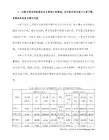
第三篇货物的交付第七章交货时间和地点学习目标:了解货物交付过程中卖方的主要义务,包括涉及交货的时间、地点和方式,装运地、目的地、运输方式、运输单据、分批装运和转运的问题等。
熟悉国际货物买卖合同中有关货物交付的条款制定。
一、单项选择题以下各题的备选答案中,均只有一个选项是最正确的1、交货时间是指( C )。
A.卖方按照自己方便的时间将合同货物交付给买方的时间。
B.卖方自行决定将合同货物交付给承运人的时间。
C.卖方按买卖合同规定的时间将合同货物交付给买方或承运人的时间。
D.卖方按买卖信用证规定的时间将合同货物交付给买方或承运人的时间3、《联合国国际货物销售合同公约》规定,如果合同未规定交货日期或一段交货时间,卖方则应(D )。
A.拒绝交货B.与买方另行商定交货日期C.立即交货D.在合同订立后一段合理时间交货5、在INCOTERMS规则中“交货”一词是用于表示货物灭失或损坏的风险自( B )的时间和地点。
A.卖方转移至承运人B.卖方转移至买方C.卖方转移至保险公司D.卖方转移至船公司7、在国际贸易的实际业务中,买卖双方应根据(B )正确选择和确定交货地点。
A.信用证要求的装运地点B.买卖合同中使用的贸易术语和运输方式C.卖方距离最近的地点D.货物情况和交货季节9、根据《跟单信用证统一惯例》的解释,除非信用证明示不准转运,卖方(B )。
A.不得转运货物B.有权转运货物C.与买方协商是否转运货物D.与承运人协商是否转运货物二、多项选择题下述各题备选答案中至少有两个选项是正确的。
1、《联合国国际货物销售合同公约》规定,如卖方在合同规定的时间以前交货,或者延迟交货,买方(ABC )。
A.有权要求损害赔偿B.有权拒收货物C.有权宣告合同无效D.必须收下货物E.与买方另行协商解决3、在出口业务中,我方决定可否接受国外客户提出的目的港和目的地时,通常应考虑的因素包括(ABE )。
A.对目的港或目的地的规定应尽量明确具体B.目的港必须是船舶可以安全停靠的港口C.以CIF或CFR条件成交的对内陆国家出口交易,应选择距离我国目的地最近的我方能够安排船舶的港口为目的港。
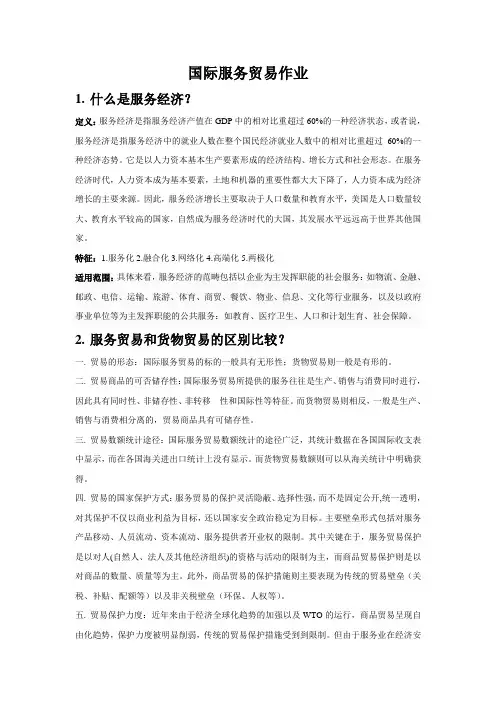
国际服务贸易作业1.什么是服务经济?定义:服务经济是指服务经济产值在GDP中的相对比重超过60%的一种经济状态,或者说,服务经济是指服务经济中的就业人数在整个国民经济就业人数中的相对比重超过60%的一种经济态势。
它是以人力资本基本生产要素形成的经济结构、增长方式和社会形态。
在服务经济时代,人力资本成为基本要素,土地和机器的重要性都大大下降了,人力资本成为经济增长的主要来源。
因此,服务经济增长主要取决于人口数量和教育水平,美国是人口数量较大、教育水平较高的国家,自然成为服务经济时代的大国,其发展水平远远高于世界其他国家。
特征:1.服务化2.融合化3.网络化4.高端化5.两极化适用范围:具体来看,服务经济的范畴包括以企业为主发挥职能的社会服务:如物流、金融、邮政、电信、运输、旅游、体育、商贸、餐饮、物业、信息、文化等行业服务,以及以政府事业单位等为主发挥职能的公共服务:如教育、医疗卫生、人口和计划生育、社会保障。
2.服务贸易和货物贸易的区别比较?一. 贸易的形态:国际服务贸易的标的一般具有无形性;货物贸易则一般是有形的。
二. 贸易商品的可否储存性:国际服务贸易所提供的服务往往是生产、销售与消费同时进行,因此具有同时性、非储存性、非转移性和国际性等特征。
而货物贸易则相反,一般是生产、销售与消费相分离的,贸易商品具有可储存性。
三. 贸易数额统计途径:国际服务贸易数额统计的途径广泛,其统计数据在各国国际收支表中显示,而在各国海关进出口统计上没有显示。
而货物贸易数额则可以从海关统计中明确获得。
四. 贸易的国家保护方式:服务贸易的保护灵活隐蔽、选择性强,而不是固定公开,统一透明,对其保护不仅以商业利益为目标,还以国家安全政治稳定为目标。
主要壁垒形式包括对服务产品移动、人员流动、资本流动、服务提供者开业权的限制。
其中关键在于,服务贸易保护是以对人(自然人、法人及其他经济组织)的资格与活动的限制为主,而商品贸易保护则是以对商品的数量、质量等为主。
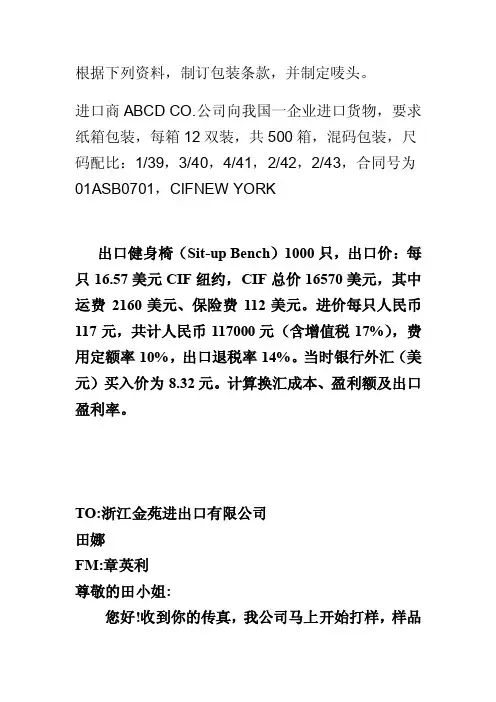
根据下列资料,制订包装条款,并制定唛头。
进口商ABCD CO.公司向我国一企业进口货物,要求纸箱包装,每箱12双装,共500箱,混码包装,尺码配比:1/39,3/40,4/41,2/42,2/43,合同号为01ASB0701,CIFNEW YORK出口健身椅(Sit-up Bench)1000只,出口价:每只16.57美元CIF纽约,CIF总价16570美元,其中运费2160美元、保险费112美元。
进价每只人民币117元,共计人民币117000元(含增值税17%),费用定额率10%,出口退税率14%。
当时银行外汇(美元)买入价为8.32元。
计算换汇成本、盈利额及出口盈利率。
TO:浙江金苑进出口有限公司田娜FM:章英利尊敬的田小姐:您好!收到你的传真,我公司马上开始打样,样品已于今天下午寄出,全棉女式夹克F123的报价及相关信息如下:面料:全棉里料:摇粒绒含税价:81.9元/件增值税率:17%包装方式:用出口纸箱包装,16件/箱包装尺寸:57厘米×44厘米×43厘米毛重:15千克/箱净重:14千克/箱月生产能力:10000件/月最底起订量:2000件/款若有其他要求,我厂会尽力予以满足。
祝工作愉快!章英利2008年4月24日当日,田娜根据这封回函和以下信息,进行出口报价核算:(1)全棉女式夹克的出口退税率为11%(2)到德国投保一切险的保险费率为2‰(3)从嘉兴运到上海港的国内运费为1200元/20英尺集装箱(4)除国内运费以外的其他所有国内费用为采购成本的5%(5)预期出口成本利润率为15%(6)经过测算,如果按照订4000件来计算,需要装一个20英尺集装箱。
同时,上海港至德国汉堡港一个20英尺集装箱的运价为1000美元。
包装方式:用出口纸箱包装,16件/箱包装尺寸:57厘米×44厘米×43厘米毛重:15千克/箱净重:14千克/箱月生产能力:10000件/月最底起订量:2000件/款若有其他要求,我厂会尽力予以满足。
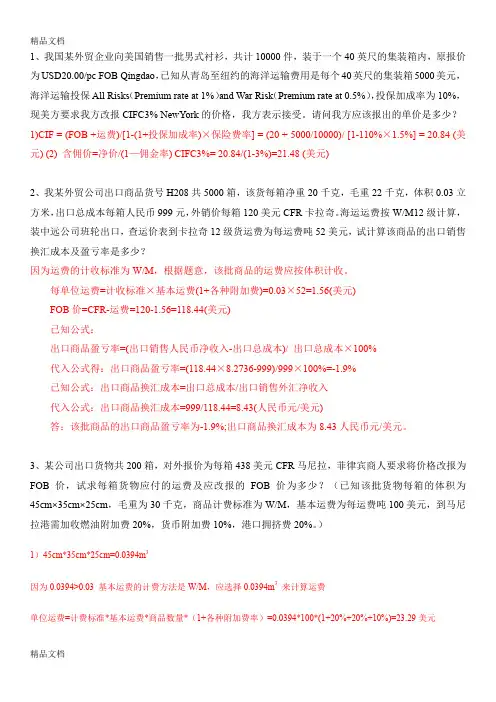
1、我国某外贸企业向美国销售一批男式衬衫,共计10000件,装于一个40英尺的集装箱内,原报价为USD20.00/pc FOB Qingdao,已知从青岛至纽约的海洋运输费用是每个40英尺的集装箱5000美元,海洋运输投保All Risks(Premium rate at 1%)and War Risk(Premium rate at 0.5%),投保加成率为10%,现美方要求我方改报CIFC3% NewYork的价格,我方表示接受。
请问我方应该报出的单价是多少?1)CIF = (FOB +运费)/[1-(1+投保加成率)×保险费率] = (20 + 5000/10000)/ [1-110%×1.5%] = 20.84 (美元) (2) 含佣价=净价/(1—佣金率)CIFC3%= 20.84/(1-3%)=21.48 (美元)2、我某外贸公司出口商品货号H208共5000箱,该货每箱净重20千克,毛重22千克,体积0.03立方米,出口总成本每箱人民币999元,外销价每箱120美元CFR卡拉奇。
海运运费按W/M12级计算,装中远公司班轮出口,查运价表到卡拉奇12级货运费为每运费吨52美元,试计算该商品的出口销售换汇成本及盈亏率是多少?因为运费的计收标准为W/M,根据题意,该批商品的运费应按体积计收。
每单位运费=计收标准×基本运费(1+各种附加费)=0.03×52=1.56(美元)FOB价=CFR-运费=120-1.56=118.44(美元)已知公式:出口商品盈亏率=(出口销售人民币净收入-出口总成本)/ 出口总成本×100%代入公式得:出口商品盈亏率=(118.44×8.2736-999)/999×100%=-1.9%已知公式:出口商品换汇成本=出口总成本/出口销售外汇净收入代入公式:出口商品换汇成本=999/118.44=8.43(人民币元/美元)答:该批商品的出口商品盈亏率为-1.9%;出口商品换汇成本为8.43人民币元/美元。
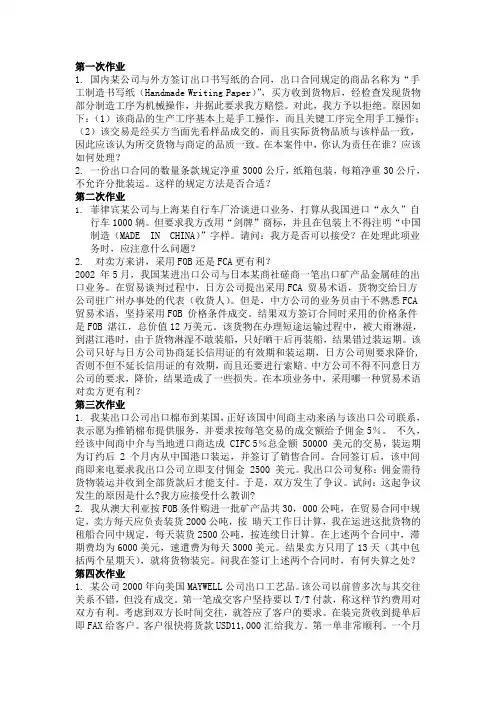
第一次作业1. 国内某公司与外方签订出口书写纸的合同,出口合同规定的商品名称为“手工制造书写纸(Handmade Writing Paper)”,买方收到货物后,经检查发现货物部分制造工序为机械操作,并据此要求我方赔偿。
对此,我方予以拒绝。
原因如下:(1)该商品的生产工序基本上是手工操作,而且关键工序完全用手工操作;(2)该交易是经买方当面先看样品成交的,而且实际货物品质与该样品一致,因此应该认为所交货物与商定的品质一致。
在本案件中,你认为责任在谁?应该如何处理?2. 一份出口合同的数量条款规定净重3000公斤,纸箱包装,每箱净重30公斤,不允许分批装运。
这样的规定方法是否合适?第二次作业1.菲律宾某公司与上海某自行车厂洽谈进口业务,打算从我国进口“永久”自行车1000辆。
但要求我方改用“剑牌”商标,并且在包装上不得注明“中国制造(MADE IN CHINA)”字样。
请问:我方是否可以接受?在处理此项业务时,应注意什么问题?2. 对卖方来讲,采用FOB还是FCA更有利?2002 年5月,我国某进出口公司与日本某商社磋商一笔出口矿产品金属硅的出口业务。
在贸易谈判过程中,日方公司提出采用FCA 贸易术语,货物交给日方公司驻广州办事处的代表(收货人)。
但是,中方公司的业务员由于不熟悉FCA 贸易术语,坚持采用FOB 价格条件成交。
结果双方签订合同时采用的价格条件是FOB 湛江,总价值12万美元。
该货物在办理短途运输过程中,被大雨淋湿,到湛江港时,由于货物淋湿不敢装船,只好晒干后再装船,结果错过装运期。
该公司只好与日方公司协商延长信用证的有效期和装运期,日方公司则要求降价,否则不但不延长信用证的有效期,而且还要进行索赔。
中方公司不得不同意日方公司的要求,降价,结果造成了一些损失。
在本项业务中,采用哪一种贸易术语对卖方更有利?第三次作业1. 我某出口公司出口棉布到某国,正好该国中间商主动来函与该出口公司联系,表示愿为推销棉布提供服务,并要求按每笔交易的成交额给予佣金5%。
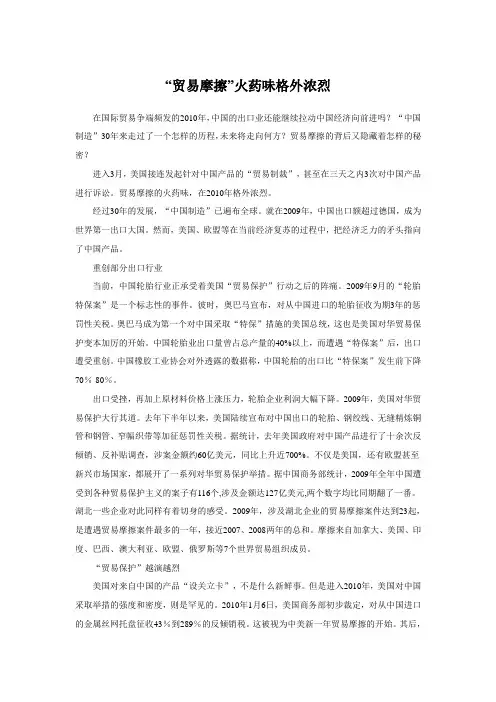
“贸易摩擦”火药味格外浓烈在国际贸易争端频发的2010年,中国的出口业还能继续拉动中国经济向前进吗?“中国制造”30年来走过了一个怎样的历程,未来将走向何方?贸易摩擦的背后又隐藏着怎样的秘密?进入3月,美国接连发起针对中国产品的“贸易制裁”,甚至在三天之内3次对中国产品进行诉讼。
贸易摩擦的火药味,在2010年格外浓烈。
经过30年的发展,“中国制造”已遍布全球。
就在2009年,中国出口额超过德国,成为世界第一出口大国。
然而,美国、欧盟等在当前经济复苏的过程中,把经济乏力的矛头指向了中国产品。
重创部分出口行业当前,中国轮胎行业正承受着美国“贸易保护”行动之后的阵痛。
2009年9月的“轮胎特保案”是一个标志性的事件。
彼时,奥巴马宣布,对从中国进口的轮胎征收为期3年的惩罚性关税。
奥巴马成为第一个对中国采取“特保”措施的美国总统,这也是美国对华贸易保护变本加厉的开始。
中国轮胎业出口量曾占总产量的40%以上,而遭遇“特保案”后,出口遭受重创。
中国橡胶工业协会对外透露的数据称,中国轮胎的出口比“特保案”发生前下降70%-80%。
出口受挫,再加上原材料价格上涨压力,轮胎企业利润大幅下降。
2009年,美国对华贸易保护大行其道。
去年下半年以来,美国陆续宣布对中国出口的轮胎、钢绞线、无缝精炼铜管和钢管、窄幅织带等加征惩罚性关税。
据统计,去年美国政府对中国产品进行了十余次反倾销、反补贴调查,涉案金额约60亿美元,同比上升近700%。
不仅是美国,还有欧盟甚至新兴市场国家,都展开了一系列对华贸易保护举措。
据中国商务部统计,2009年全年中国遭受到各种贸易保护主义的案子有116个,涉及金额达127亿美元,两个数字均比同期翻了一番。
湖北一些企业对此同样有着切身的感受。
2009年,涉及湖北企业的贸易摩擦案件达到23起,是遭遇贸易摩擦案件最多的一年,接近2007、2008两年的总和。
摩擦来自加拿大、美国、印度、巴西、澳大利亚、欧盟、俄罗斯等7个世界贸易组织成员。
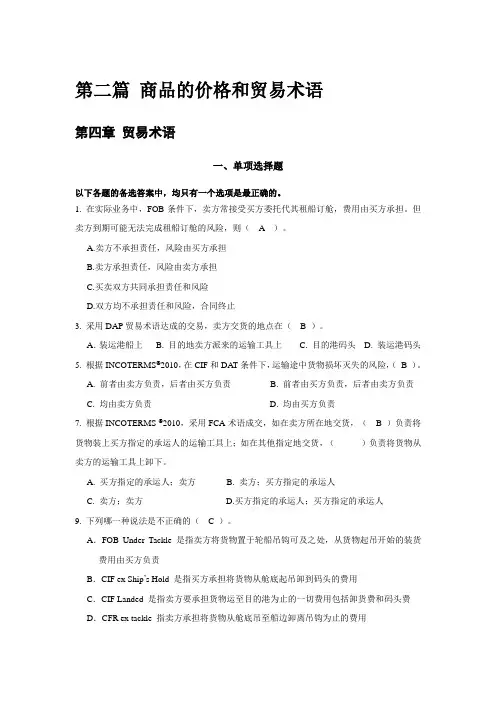
第二篇商品的价格和贸易术语第四章贸易术语一、单项选择题以下各题的备选答案中,均只有一个选项是最正确的。
1. 在实际业务中,FOB条件下,卖方常接受买方委托代其租船订舱,费用由买方承担。
但卖方到期可能无法完成租船订舱的风险,则( A )。
A.卖方不承担责任,风险由买方承担B.卖方承担责任,风险由卖方承担C.买卖双方共同承担责任和风险D.双方均不承担责任和风险,合同终止3. 采用DAP贸易术语达成的交易,卖方交货的地点在( B )。
A.装运港船上 B. 目的地卖方派来的运输工具上 C. 目的港码头 D. 装运港码头5. 根据INCOTERMS®2010,在CIF和DAT条件下,运输途中货物损坏灭失的风险,(B )。
A. 前者由卖方负责,后者由买方负责B. 前者由买方负责,后者由卖方负责C. 均由卖方负责D. 均由买方负责7. 根据INCOTERMS ®2010,采用FCA术语成交,如在卖方所在地交货,( B )负责将货物装上买方指定的承运人的运输工具上;如在其他指定地交货,()负责将货物从卖方的运输工具上卸下。
A. 买方指定的承运人;卖方B. 卖方;买方指定的承运人C. 卖方;卖方D.买方指定的承运人;买方指定的承运人9. 下列哪一种说法是不正确的( C )。
A.FOB Under Tackle 是指卖方将货物置于轮船吊钩可及之处,从货物起吊开始的装货费用由买方负责B.CIF ex Ship’s Hold 是指买方承担将货物从舱底起吊卸到码头的费用C.CIF Landed 是指卖方要承担货物运至目的港为止的一切费用包括卸货费和码头费D.CFR ex tackle 指卖方承担将货物从舱底吊至船边卸离吊钩为止的费用11. 根据INCOTERMS®2010,FOB合同,办理投保手续是( A )的义务。
A.买方B.卖方C.买卖双方都无办保险的义务D.以上都不正确13. 采用CIF 术语成交时,如果卖方负担将货物卸到码头上的各项有关费用,包括驳船费和码头费,可采用的变形是(B )。
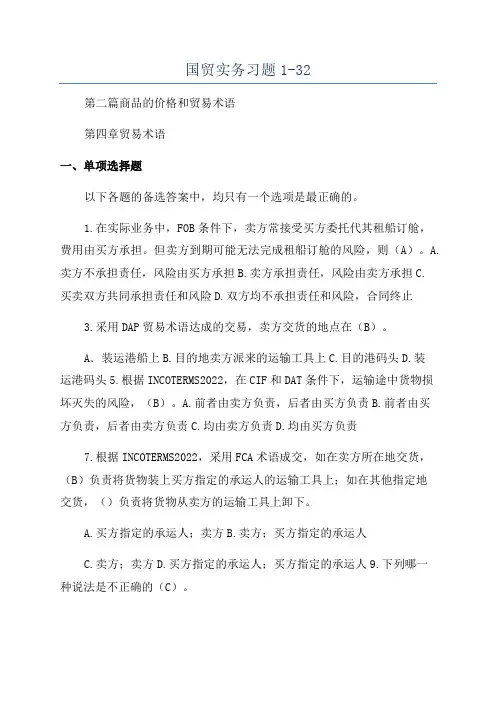
国贸实务习题1-32第二篇商品的价格和贸易术语第四章贸易术语一、单项选择题以下各题的备选答案中,均只有一个选项是最正确的。
1.在实际业务中,FOB条件下,卖方常接受买方委托代其租船订舱,费用由买方承担。
但卖方到期可能无法完成租船订舱的风险,则(A)。
A.卖方不承担责任,风险由买方承担B.卖方承担责任,风险由卖方承担C.买卖双方共同承担责任和风险D.双方均不承担责任和风险,合同终止3.采用DAP贸易术语达成的交易,卖方交货的地点在(B)。
A.装运港船上B.目的地卖方派来的运输工具上C.目的港码头D.装运港码头5.根据INCOTERMS2022,在CIF和DAT条件下,运输途中货物损坏灭失的风险,(B)。
A.前者由卖方负责,后者由买方负责B.前者由买方负责,后者由卖方负责C.均由卖方负责D.均由买方负责7.根据INCOTERMS2022,采用FCA术语成交,如在卖方所在地交货,(B)负责将货物装上买方指定的承运人的运输工具上;如在其他指定地交货,()负责将货物从卖方的运输工具上卸下。
A.买方指定的承运人;卖方B.卖方;买方指定的承运人C.卖方;卖方D.买方指定的承运人;买方指定的承运人9.下列哪一种说法是不正确的(C)。
A.FOBUnderTackle是指卖方将货物置于轮船吊钩可及之处,从货物起吊开始的装货费用由买方负责B.CIFe某Ship’Hold是指买方承担将货物从舱底起吊卸到码头的费用C.CIFLanded是指卖方要承担货物运至目的港为止的一切费用包括卸货费和码头费D.CFRe某tackle指卖方承担将货物从舱底吊至船边卸离吊钩为止的费用11.根据INCOTERMS2022,FOB合同,办理投保手续是(A)的义务。
A.买方B.卖方C.买卖双方都无办保险的义务D.以上都不正确13.采用CIF术语成交时,如果卖方负担将货物卸到码头上的各项有关费用,包括驳船费和码头费,可采用的变形是(B)A.CIFLinerTermB.CIFLandedC.CIFE某TackleD.CIFShip'Hold15.按CFR条件达成的合同,凡需程租船运输的大宗货物,适宜在合同中具体定明(B)A.装船费用由谁负担B.卸货费用由谁负担C.保险费用由谁负担D.运费由谁负担17.根据INCOTERMS2022,按FCA价出口与按FOB价出口相比,卖方所承担的风险(A)。
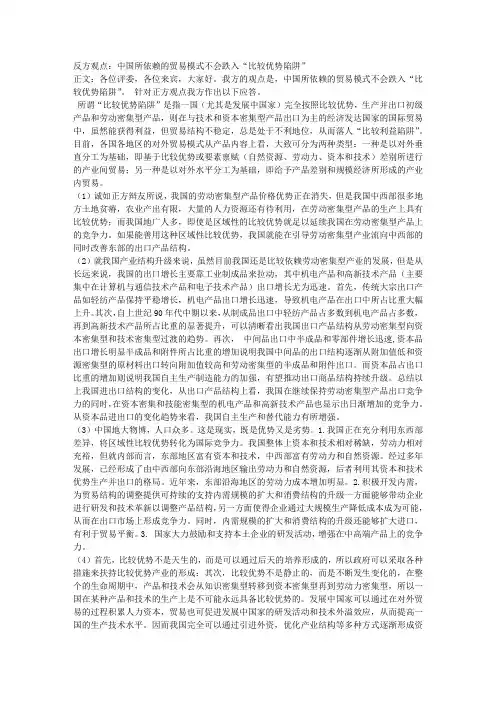
反方观点:中国所依赖的贸易模式不会跌入“比较优势陷阱”正文:各位评委,各位来宾,大家好。
我方的观点是,中国所依赖的贸易模式不会跌入“比较优势陷阱”。
针对正方观点我方作出以下应答。
所谓“比较优势陷阱”是指一国(尤其是发展中国家)完全按照比较优势,生产并出口初级产品和劳动密集型产品,则在与技术和资本密集型产品出口为主的经济发达国家的国际贸易中,虽然能获得利益,但贸易结构不稳定,总是处于不利地位,从而落人“比较利益陷阱”。
目前,各国各地区的对外贸易模式从产品内容上看,大致可分为两种类型:一种是以对外垂直分工为基础,即基于比较优势或要素禀赋(自然资源、劳动力、资本和技术)差别所进行的产业间贸易;另一种是以对外水平分工为基础,即给予产品差别和规模经济所形成的产业内贸易。
(1)诚如正方辩友所说,我国的劳动密集型产品价格优势正在消失,但是我国中西部很多地方土地贫瘠,农业产出有限,大量的人力资源还有待利用,在劳动密集型产品的生产上具有比较优势;而我国地广人多,即使是区域性的比较优势就足以延续我国在劳动密集型产品上的竞争力。
如果能善用这种区域性比较优势,我国就能在引导劳动密集型产业流向中西部的同时改善东部的出口产品结构。
(2)就我国产业结构升级来说,虽然目前我国还是比较依赖劳动密集型产业的发展,但是从长远来说,我国的出口增长主要靠工业制成品来拉动,其中机电产品和高新技术产品(主要集中在计算机与通信技术产品和电子技术产品)出口增长尤为迅速。
首先,传统大宗出口产品如轻纺产品保持平稳增长,机电产品出口增长迅速,导致机电产品在出口中所占比重大幅上升。
其次,自上世纪90年代中期以来,从制成品出口中轻纺产品占多数到机电产品占多数,再到高新技术产品所占比重的显著提升,可以清晰看出我国出口产品结构从劳动密集型向资本密集型和技术密集型过渡的趋势。
再次,中间品出口中半成品和零部件增长迅速,资本品出口增长明显半成品和附件所占比重的增加说明我国中间品的出口结构逐渐从附加值低和资源密集型的原材料出口转向附加值较高和劳动密集型的半成品和附件出口。
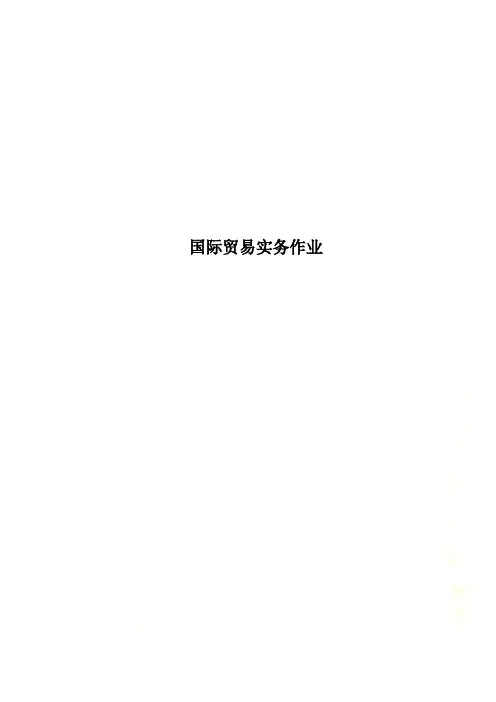
国际贸易实务作业第一次作业:技能实训1.这是日本A公司向国内B公司电洽购买玩具,两家公司进行的交易磋商过程。
请指出,每一次函电表示的法律含义(询盘、发盘、还盘、接受)(1)Dec.8 Incoming: WHITE SNOW BRAND TOY TYA22 BEAR TYA221 DOG TYA322 DUCK PLEASE CABLE REPLY PRESENT PRICE AND A V AILABLE QUANTITY FOR JAN SHIPMENT.(2)Dec. 10 Outgoing: YOURS 8TH REFERENCE PRICE CIF OSAKA TYA22 BEAR USD 0.45 TYA221 DOG0.60 TYA322 DUCK 0.50 IN CARTONS OF 500 PCS EACH.(3) Dec. 11 Incoming: YOURS 10TH INTERESTED 3000 PCS EACH JAN SHIPMENT PLEASE OFFER FIRM.(4) Dec. 15 Outgoing: YOURS 11TH OFFER SUBJECT TO REPLY HERE BY 22TH DEC. 2000 PCS TYA22 USD 0.45 2000 PCS TYA221 0.60 3000 PCS TYA 322 0.50 FEB SHIPMENT LC SIGHT.(5) Dec. 17 Incoming: YOURS 15TH USD 0.36 0.48 0.40 3000 PCS EACH JAN/FEB LC 30 DAYS SIGHT REPLY IMMEDIATELY.(6) Dec. 19 Outgoing: YOURS 17TH3000 PCS EACH TYA 22 0.40 TYA221 0.53 TYA322 0.44 JAN/FEB SHIPMENT INSURANCE AMOUNT 110 PERCENT IN VOICE V ALUE AGAINST ALL RISKS WAR RISKS OTHERS SAME AS OURS 15TH, THE OFFER IS OPEN FOR ONE WEEK.(17) Dec. 22 Incoming: ACCEPT PLEASE SENT SALES CONFIRMATION IN DUPLICATE.2.请为面粉,MP3,自行车,毛绒玩具这四项产品拟写合同中的商品品质条款。

作业11、发盘成立的条件2、接受成立的条件3、买卖合同中的数量条款规定“l00M / T 5 % more or less at seller”s option " ,则根据《公约》的规定,卖方最多和最少可交多少公吨货物?多交部分如何作价?若双方未约定多交部分如何作价,当市场价格上涨时,卖方应该多交还是少交?4、我国嘉骏贸易有限公司向日本信诚贸易有限公司出口某产品500 箱,已知收货人代号为:JQL ;目的地为:Osaka Japan ;参考号为:01 一368 一98 ,请根据以上已知条件制作一标准化唛头。
5、我方向西欧某国出口布匹一批,货到目的港后,买方因购销旺季,未对货物进行检验就将布匹投入批量生产。
数月后,买方寄来几套不同款式的服装,声称用我方出口的布匹制成的服装缩水严重,难以投入市场销售,因而向我方提出索赔。
问:我方是否应该理赔?为什么?作业21、我某进出口公司对日本某客户发盘,供应棉织浴巾4000打,每打CIF大阪80美元,装运港大连;现日商要求我方改报FOB 大连价,问:我出口公司对价格应如何调整?如果最后按FOB 条件签订合同,买卖双方在所承担的责任、费用和风险方面有什么区别?2、我方以FCA贸易术语从意大利进口布料一批,双方约定最迟的装运期为4月12 日,由于我方业务员的疏忽,导致意大利出口商在 4 月15日才将货物交给我方指定的承运人。
当我方收到货物后,发现部分货物有水渍,据查是因为货交承运人前两天大雨淋湿所致。
据此,我方向意大利出口商提出索赔,但遭到拒绝。
问:我方的索赔是否有理?为什么?3、我方与荷兰某客商CIF条件成交一笔交易,合同规定以信用证为付款方式。
卖方收到买方开来的信用证后,及时办理了装运手续,并制作好一整套结汇单据。
在卖方准备到银行办理议付手续时,收到买方来电,得知载货船只在航海运输途中遭遇意外事故,大部分货物受损,据此,买方表示将等到具体货损情况确定以后,才同意银行向卖方支付货款。
案例1国内某单位向英国出口一批大豆,合同规定水分最高为14%,杂质不超过2.5%,在成交前我方曾向买方寄过样品,订约后我方又电告买方成交货物及样品相似,当货物运到英国后,买方提出货物及样品不符,并出示相应的检验证书证书货物的质量比样品低7%,并以此要求我方赔偿15000英镑的损失。
请问:在此情况下我方是否可以该项交易并非凭样品买卖而不予理赔?分析要点:合同规定水分最高为14%,杂质不超过2.5%,从合同内容看,在这笔进出口交易中,双方以商品的规格作为表示商品品质的方法,并以此作为交验商品的依据,属于凭规格的买卖,只要我方所交货物符合合同规定的规格,我方就算已经履行了合同。
但是成交前我方向对方寄送样品时并未声明是参考样品,签约后又电告对方成交货物及样品相似,这样对方就有理由认为该笔交易既凭规格又凭样品。
而在国际贸易中,凡属于凭样买卖,卖方所交货物必须及样品完全一致,否那么买方有权拒收货物或提出索赔。
因此,在这种情况下,我方很难以该笔交易并非凭样买卖为由不予理赔。
案例2青岛某纺织厂向加拿大出口一批绣花被罩,国外要求花绣在被罩的横面。
但合同签订后,该厂在加工时,认为花纹应绣在被罩的竖面才较明显,便擅自决定改变了绣花部位。
货物出口到国外后,买方以布局及合同不符为由,要求全部退货。
请问我方应如何处理较为妥当?分析要点:在进出口业务中,如果卖方所交货物的品质及合同规定不符,买方有权拒收货物或提出索赔要求。
因此,在上述案例中我方不能拒绝对方的退货要求。
但从我方的利益看,由于货物已经生产出来并已出运国外,如果承受对方的退货要求,并将货物运回国内,将使我出口企业蒙受巨大经济损失。
为了减少我方的损失,我方应该争取在我方提供一定经济补偿的条件下使买方接收货物,或者将出口合同改为由买方代表。
在买方拒绝上述两项建议的情况下,也要积极寻找其它的买主或代卖商。
案例3某厂外销布匹4万米,合同上订明:红白黄绿四种颜色各一万米,并附有允许卖方溢短装10%的条件。
国际贸易理论作业答案作业一1、以2008年为基期,某国该年的进出口价格指数均定为100。
2009年该国进口贸易额为1170亿美元,出口贸易额为1200亿美元。
2009年该国出口产品价格平均下跌8%;2009年该国进口产品价格平均上涨5%。
计算2009年的对外贸易量。
解答:报告期:出口价格指数为92(100-8),进口价格指数为105(100+5)出口贸易量=(1200÷92)×100=进口贸易量=(1170÷105)×100=2、假定以2005年为基期,2006年出口价格指数为80%,进口价格指数为110%,出口商品数量指数为140%,计算该年的净贸易条件,并解释结果。
解答:净贸易条件=(Px/Pm)×100%=80%÷110%×100%=72.7%收入贸易条件=(Px/Pm)×Qx=80%÷110%×140%=101.8%解释:该国净贸易条件恶化,但由于出口规模扩张,因而扭转出口商品价格相对于进口商品价格变化所处的不利局面,而且使该国的进口能力提高了1.8%。
3、说明:即使一国在某一商品上具有绝对优势,也未必具有比较优势。
答案提示:设:A、B两国分别生产两种商品:X、Y(利用一种要素)(1)一国处于绝对优势(设A国生产X产品处于绝对优势),则有:(2)如果两国存在比较优势,则有:(3)当或者的时候,由可以推出,但是,当的时候,不能保证。
所以,即使一国在某一商品上具有绝对优势,也未必具有比较优势。
4、根据下面的两个表(A/B分别表示两个国家),分别判断:(1)哪个国家是资本相对丰富的;(2)哪个国家是劳动相对丰富的;(3)如果X是资本密集型产品,Y是劳动密集型产品,那么两国的比较优势如何?表1要素禀赋 A B劳动资本45152010表2要素禀赋 A B劳动资本12483060提示:1、相对要素供给分析:表一:A国:人均资本=15资本/45劳动=0.3资本/劳动(劳动丰裕)生产Y产品B国:人均资本=10资本/20劳动=0.5资本/劳动(资本丰裕)生产X产品表二(同理)A国:人均资本=48资本/12劳动=4资本/劳动(资本丰裕)生产X产品B国:人均资本=60资本/30劳动=2资本/劳动(劳动丰裕) 生产Y产品2、相对要素价格分析表一:A国:K/L=15/45=0.3; K=0.3L 资本丰裕B国:K/L=10/20=0.5; K=0.5L 劳动丰裕(Y)同理表二:A国:劳动丰裕B国:资本丰裕5、简述大卫.李嘉图比较优势的主要内容作业二某出口公司出口一批陶瓷茶具到加拿大,供货价格中含17%增值税,出口退税率9%,出口一个20英尺集装箱发生的国内费用:运杂费800元人民币,商检费150元,报关费50元,港区港杂费650元,公司业务费1200元,其他费用900元。
1.下表列出了加拿大和中国生产1单位计算机和1单位小麦所需的劳动时间。
假定生产计算机和小麦都只用劳动,加拿大的总劳动力为600小时,中国的总劳动力为800小时。
(1)计算不发生贸易时各国生产计算机的机会成本。
(2)哪个国家具有生产计算机的比较优势?哪个国家具有生产小麦的比较优势?(3)如果给定世界价格是1单位计算机交换22单位小麦,加拿大参与贸易可以从每单位的进口中节省多少劳动时间?中国可以从每单位进口中节省多少劳动时间?如果给定世界价格是1单位计算机交换24单位小麦,加拿大和中国分别可以从进口每单位的货物中节省多少劳动时间?(4)在自由贸易的情况下,各国应生产什么产品,数量是多少?整个世界的福利水平是提高还是降低了?试用图分析(以效用水平来衡量福利水平)。
答:1、中国生产计算机的机会成本为100/4=25,加拿大为60/3=202、因为加拿大生产计算机的机会成本比中国低,所以加拿大具有生产者计算机的比较优势,中国就具有生产小麦的比较优势。
3、如果各国按照比较优势生产和出口,加拿大进口小麦出口计算机,中国进口计算机出口小麦。
加拿大进口一单位小麦需要出口1/22单位计算机,折合成劳动时间来算,生产一单位小麦本国要用3小时,但生产1/22单位计算机本国要用60/22小时劳动,所以加拿大进口一单位小麦相当于用60/22小时的劳动换回本国3小时生产的产品,节省了3-60/22=3/11小时的劳动时间。
中国进口一单位计算机需要出口22单位小麦,相当于用22*4=88小时的劳动换回本国需用100小时生产的产品,节省了100-88=12小时的劳动时间。
如果世界价格是1单位计算机交换24单位的小麦,则相当于用60/24小时的劳动换回本国3小时生产的产品,节省了3-60/24=1/2小时的劳动时间。
中国进口一单位计算机需要出口24单位小麦,相当于用24*4=96小时的劳动换回本国需用100小时生产的产品,节省了100-96=4小时的劳动时间。
1.我方向西欧某客商推销某商品,发盘价格为每公吨1150英镑CFR西欧某港口,对方复电要求改按FOB中国口岸定价,并给予2%佣金。
查自中国口岸至西欧某港口的运费为每公吨170英磅,我方如要保持外汇收入不变,改按买方要求报价FOBC2%,应为何价?
注:FOBC2%,包含2%佣金的价格;含佣价=净价/(1-佣金率)
2. 商品名称:陶瓷餐茶具
1)货号:HX1115 品名:35头餐茶具
包装:1套/纸箱尺码:40×32×36(厘米)
毛/净重:20/14千克(毛重:20kg,净重:14kg)供货单价:152元/套
2)货号:HX1128 品名:15头餐茶具
包装:2套/纸箱尺码:44×32.5×40(厘米)
毛/净重:19/13千克供货单价:100元/套
税率:供货单价中包括17%的增值税,退税率为9%
国内费用:出口一个20英尺的集装箱的费用有:运杂费800元,商检费150元,报关费50元,港区港杂费650元,公司业务费1200元,其他费用900元
海洋运费:从上海到多伦多一个20英尺集装箱的包厢费率1750美元
保险:CIF成交金额加10%投保水渍险、碰损破碎险、战争险,费率0.5%、0.3%、0.16%利润:报价10%
汇率:6.10元人民币兑换1美元
分别报出2个货号陶瓷餐具出口的FOB、CFR和CIF美元单价(各出口一20英尺集装箱)。
第一篇合同的标的第一章商品的名称和质量学习目标:了解商品名称与商品质量的含义及其表示方法,熟悉采用实物样品与文字说明表示商品质量所适用的条件,掌握质量机动幅度与质量公差在合同条款中的运用。
一、单项选择题以下各题的备选答案中,均只有一个选项是最正确的。
1.在品质条款的规定上,对比较难掌握其品质的工业制成品或初级产品,一般在合同中会规定( C )。
A.溢短装条款B.增减价条款C.品质公差或品质机动幅度D.以毛作净3. 合同中品质机动幅度条款一般适用于( B )交易。
A.工业制成品B.初级产品C.机电产品D.精密仪表5. 若合同规定有品质公差条款,则在公差范围内,买方( A )。
A.不得拒收货物B.可以拒收货物C.可以要求调整价格D.可以拒收货物也可以要求调整价格7. 目前我国出口的某些工艺品、服装、轻工业品等常用来表示品质的方法是( A )。
A.凭样品买卖B.凭规格买卖C.凭等级买卖D.凭产地名称买卖9. 凡货、样难以达到完全一致的,不宜采用( B )。
A.凭说明买卖B.凭样品买卖C.凭等级买卖D.凭规格买卖11.在国际贸易中,技术密集型的机器设备、精密仪器仪表等产品适应的品质表示方法为( A )。
A.说明书图样B.商品牌号C.样品D.规格等级标准13. 对外订立品质条款对应注意的问题不正确的是( D )。
A.根据商品不同特点确定不同的表示方法B.表明商品品质的文字要准确C.尽量规定品质公差或机动幅度D.尽量以最高标准规定品质15.我某进出口公司拟向马来西亚客商出口服装一批,在洽谈合同条款时,就服装的款式可要求买方提供( A )。
A.样品B.规格C.商标D.产地17. “龙口粉丝”中用来表面商品品质的方法是( D )。
A.凭商标或品牌B.凭标准C.凭规格D.凭产地名称19. 卖方根据买方提供的样品加工复制出一个类似的样品提供买方确认,经确认的样品叫( B )。
A.复样B.回样C.参考样品D.卖主样品二、多项选择题下述各题备选答案中至少有两个选项是正确的。
Assignment 1CHAPTER 2EARLY TRADE THEORIES:Mercantilism and the Transition to the Classical World of David RicardoPart 1. Multiple-Choice Questions (only one answer is right)1. In the price-specie-flow doctrine, a deficit country will __________ gold, and this goldflow will ultimately lead to __________ in the deficit country’s exports.a. lose; a decreaseb. lose; an increasec. gain; a decreased. gain; an increase2. In the Mercantilist view of international trade (in a two-country world),a. both countries could gain from trade at the same time, but the distribution of the gainsdepended upon the terms of trade.b. both countries could gain from trade at the same time, and the terms of trade were ofno consequence for the distribution of the gains.c. neither country could ever gain from trade.d. one country’s gain from trade was associated with a loss for the other country.3. According to the labor theory of value,a. the value of labor is determined by its value in production.b. the value of a good is determined by the amount of labor with which each unit ofcapital in an industry works.c. the price of a good A compared to the price of good B bears the same relationship asthe relative amounts of labor used in producing each good.d. the values of two minerals such as coal and gold with similar production costs may bevery different.4. If the demand for traded goods is price-inelastic, the price-specie-flow mechanism will1result ina. gold movements between countries that remove trade deficits and surpluses.b. gold movements between countries that worsen trade deficits and surpluses.c. negligible movements of gold between countries and hence little or no adjustment oftrade deficits and surpluses.d. a removal of the basis for trade between countries.5. In Adam Smith’s view, international tradea. benefited both trading countries.b. was based on absolute cost differences.c. reflected the resource base of the countries in question.d. all of the above.6. Which of the following policies would NOT be consistent with the Mercantilist balance-of-trade doctrine?a. payment of high wages to laborb. import duties on final productsc. export subsidiesd. prohibition of imports of manufactured goods7. During the price-specie-flow adjustment process to a trade imbalance, if demands forgoods are inelastic, then, when the price level __________ in the country with the trade deficit, the value of that country’s exports will __________ as the price-specie-flowprocess takes place.a. falls; increaseb. falls; decreasec. rises; increased. rises; decrease8. David Hume’s price-specie-flow mechanisma. reinforced the Mercantilist notion that a country could maintain a permanent“favorable” balance of trade where exports exceeded imports.b. works more effectively if demands for traded goods are “price-elastic” rather than“price-inelastic.”c. assumed that the countries involved have substantial unemployment.d. works equa lly effectively whether demands for traded goods are “price-elastic” or“price-inelastic.”29. The price-specie-flow mechanism suggested thata. a country could easily maintain a balance-of-payments surplus for a long period oftime.b. a deficit country would experience an increase in its money supply and its price level.c. a surplus country would experience an increase in its money supply and its price level.d. a country’s internal price level has no relation to the country’s foreign trade activities.10. The policy of minimum government interference in or regulation of economic activity,advocated by Adam Smith and the Classical economists, was known asa. the law of comparative advantage.b. laissez-faire.c. the labor theory of value.d. Mercantilism.11. A Mercantilist policymaker would be in favor of which of the following policies orevents pertaining to his/her country?a. a decrease in the size of the populationb. a minimum wage bill to protect the standard of living of workersc. a prohibition on the export of manufactured goodsd. an increase in the percentage of factors of production devoted to adding value toimported raw materials in order to later export the resulting manufactured goods. 12. In the context of David Hume’s price-specie-flow mechanism that challenged thefeasibility of the Mercantilist ideas regarding a trade surplus, which one of the following statements is NOT correct?a. There is a decrease in the money supply in the deficit country.b. There is an increase in the price level in the surplus country.c. There is an increase in real income in the surplus country.d. Price changes in the surplus country cause that country’s exports to decrease.13. In David Hume’s price-specie-flow doctrine or adjustment mechanism, the assumption ismade that changes in the money supply have an impact on __________. Further, thedemand for traded goods is assumed to be __________ with respect to price.a. prices rather than on output; elasticb. prices rather than on output; inelasticc. output rather than on prices; elasticd. output rather than on prices; inelastic14. The “paradox of Mercantilism” reflected that fact that3a. trade surpluses were fostered by protective tariffs.b. rich countries were comprised of large numbers of poor people.c. gold inflows led to higher prices and reduced exports.d. gold could not be hoarded and provide money for the economy at the same time.15. Given the following Classical-type table showing the number of days of labor inputrequired to obtain one unit of output of each of the two commodities in each of the twocountries:bicycles computersUnited States 4 days 3 daysUnited Kingdom 5 days 6 daysThe United States has an absolute advantage in the production of __________.a. bicycles (only)b. computers (only)c. both bicycles and computersd. neither bicycles nor computers16. With M S = supply of money, V = velocity of money, P = price level, and Y = real output,which one of the following indicates the quantity theory of money expression?a. M S Y = PVb. M S P = VYc. M S = PY - Vd. M S V = PY17. In the price-specie-flow mechanism, there is a gold __________ a country with a balance-of-trade surplus, and this gold flow ultimately leads to __________ in the surpluscountry’s exp orts.a. inflow into; an increaseb. inflow into; a decreasec. outflow from; an increased. outflow from; a decrease18. In the price-specie-flow adjustment mechanism, a country with a balance-of-trade surplusexperiencesa. a gold inflow and a decrease in the price level.4b. a gold outflow and an increase in the money supply.c. an increase in the money supply and a decrease in exports.d. a decrease in the money supply and a decrease in imports.19. Suppose that country A’s total exports are 10,000 units of good X at a price of $20 perunit, meaning that country A’s export earnings or receipts are $200,000. Suppose alsothat the foreign price elasticity of demand for country A’s exports of good X is (-) 0.6. If country A’s prices for all goods, including its exports, now rise by 10% because of a gold inflow such as in the Mercantilist model, then, other things equal, country A’s exports of good X will fall by __________ and country A’s export earni ngs or receipts will become __________.a. 600 units; less than $200,000b. 600 units; greater than $200,000c. 1,000 units; less than $200,000d. 1,000 units; greater than $200,000Part 2 DefinitionMercantilismCHAPTER 3THE CLASSICAL WORLD OF DAVID RICARDO AND COMPARATIVE ADVANTAGEPart 1. Multiple-Choice Questions1. In the following Classical-type table showing the output per 10-days of labor input in eachof the two commodities in each of the two countries,Cameras Wine5France 100 units 40 unitsGermany 150 units 50 unitsa. Germany has a comparative advantage in both goods.b. France has an absolute advantage in both goods.c. France has a comparative advantage in cameras.d. the pretrade price ratio in France is 1 wine = 2.5 cameras.2. Given the following Ricardo-type table shows the labor input required per unit of outputin each of the two industries in each of the two countries:Shirts BrandyUnited States 4 days 12 daysFrance 6 days 12 daysWhich one of the following statements is correct?a. France’s pretrade price ratio is 1 brandy = 2 shirts.b. The U.S. pretrade price ratio is 1 shirt = 3 brandy.c. The United States has an absolute advantage in both goods.d. France will export shirts after trade begins.3. In the situation in Question #2 above, if the countries engage in trade at posttrade prices(terms of trade) of 1 shirt = 0.5 brandy, thena. France gets all the gains from trade.b. the United States gets all the gains from trade.c. neither country gains from trade.d. the two countries share equally in the gains from trade.4. The assumption of constant costs of production in the Classical model results in a__________ production possibilities frontier, and, in the case of a “small” country,__________ specialization in production when trade takes place.a. linear; incompleteb. concave-to-the-origin; completec. convex-to-the-origin; incompleted. linear; complete5. In the Classical (Ricardo) analysis,6a. if a country has an absolute advantage in a good, it also has a comparative advantagein the good.b. if a country has a comparative advantage in a good, it cannot have an absoluteadvantage in the good.c. a country can have a comparative advantage in a good at the same time that it has anabsolute advantage in that good.d. a country with an absolute advantage in all goods cannot gain from trade.6. Given the following Ricardo-type table shows the labor input required per unit of output ineach of the two industries in each of the two countries:Steel ClothUnited Kingdom 4 days 8 daysGermany 6 days 9 daysWhich one of the following statements is true?a. The United Kingdom has an absolute advantage in both goods and a comparativeadvantage in cloth.b. The pretrade price ratio in the United Kingdom is 1 steel:2 cloth.c. The United Kingdom has an absolute advantage in neither good but a comparativeadvantage in steel.d. The pretrade price ratio in Germany is 1 cloth:1.5 steel.7. Given the information in Question #6 above, suppose that Germany is a much larger country in terms of production and income than is the United Kingdom. In this situation, other things equal, when the countries engage in trade, the posttrade price ratio (terms of trade) would tend to settle __________, and __________ would therefore tend to have relatively large gains from trade.a. toward a value of 1 cloth:2 steel; the United Kingdomb. toward a value of 1 cloth:2 steel; Germanyc. toward a value of 1 cloth:1.5 steel; the United Kingdomd. toward a value of 1 cloth:1.5 steel; Germany8. Given the following Ricardo-type table showing the amount of labor input needed to get one unit of output in each industry in each country:Wheat Chairs7Malaysia 3 days 2 daysIndia 10 days 8 daysa. Terms of trade of 1 wheat:1.25 chairs is not a feasible equilibrium terms of trade.b. Terms of trade of 1 wheat:1.5 chairs would give all the gains from trade to India.c. Malaysia has an absolute advantage in both goods and a comparative advantage inwheat.d. India has an absolute advantage in both goods and a comparative advantage in wheat.9. If a country’s relative price of X (compared to Y) in autarky is greater than the s ame relativeprices on the world market, then the country has a comparative advantage in good__________, and it will __________.a. X; export Y and import Xb. X; export X and import Yc. Y; export Y and import Xd. Y; export X and import Y10. As a country moves from autarky to trade, the relative price of the country’s import good will __________ for home consumers, and the relative price of the country’s export good __________ for home consumers.a. fall; will riseb. fall; also will fallc. rise; also will rised. rise; will fall11. Suppose that, in a Classical constant-opportunity-costs framework, country I can produce15 units of wheat if it devotes all of its resources to wheat production and 45 units ofclothing if it devotes all of its resources to clothing production. In a trading situation for this country, if the world price ratio is P wheat/P clothing= ⅓ (or P clothing/P wheat = 3), country Iwoulda. export wheat and import clothing.b. export clothing and import wheat.c. be indifferent to trade.d. export either clothing or wheat and import either wheat or clothing – cannot bedetermined without more information.12. Suppose that, with constant opportunity costs, Spain can produce 2,000 units of clothing ifit devotes all of its resources to clothing production and 8,000 units of wheat if it devotes all of its resources to wheat production. If Spain is opened to trade at a world price ratio of1 wheat:0.4 clothing (or 1 clothing:2.5 wheat), Spain will export __________; if the worldprice ratio were 1 wheat:4 clothing (or 1 clothing:2.5 wheat), Spain would __________.89a. wheat; also export wheatb. wheat; would export clothingc. clothing; also would export clothingd. clothing; would be indifferent to trade13.Given the following constant-cost production-possibilities frontiers for Pakistan and India:Pakistan has an autarky relative price of __________; if trade begins with India, then Pakistan would produce at point __________, assuming complete specialization.a. 1 cloth:0.5 wheat (i.e., P cloth /P wheat = 0.5); Ab. 1 cloth:0.5 wheat (i.e., P cloth /P wheat = 0.5); Bc. 1 cloth:2 wheat (i.e., P cloth /P wheat = 2); Ad. 1 cloth:2 wheat (i.e., P cloth /P wheat = 2); B14. Country A has the following constant-opportunity-costs production-possibilities frontier(PPF):Suppose that this country in autarky is located at point R on its PPF, where it is producing 300 units of good Y and __________ of good X. Suppose that country A is now opened to trade and can trade at a terms of trade of 1X:3Y. Assuming complete specialization inproduction, the country will now produce at __________.a. 50 units; point N and will export good X and import good Yb. 150 units; point N and will export good X and import good Yc. 50 units; point M and will export good Y and import good Xd. 150 units; point M and will export good Y and import good X15. If, in a two-commodity, two-country Classical world, Sweden can make a unit of furniturewith 10 days of labor and a unit of steel with 15 days labor, while Germany can make a unit of furniture with 12 days of labor and a unit of steel with 12 days labor, thena. Sweden has an absolute advantage in steel and Germany has an absolute advantage infurniture.b. Sweden has a comparative advantage in steel and Germany has a comparativeadvantage in furniture.c. the pretrade price ratios indicate that Germany will export steel if trade takes place.d. the pretrade price ratio in Sweden is 1 furniture:1.5 steel.16. Given the following Ricardo-type table showing the amount of labor input required toproduce one unit of output of each of the two goods in each of the two countries:Wheat ClothingUnited Kingdom 6 days 5 daysUnited States 4 days 3 daysa. The United Kingdom has an absolute advantage in neither good.b. The United States has a comparative advantage in wheat.c. The United States has a comparative advantage in both goods.d. A post-trade price ratio (terms of trade) of 1 wheat:1.5 clothing is a feasibleequilibrium post-trade price ratio.17. In Question #16 above,a. if the United Kingdom were a much larger country than the United States, then, otherthings equal, the terms of trade would tend to be located more toward the U.S.pre-trade price ratio than toward the U.K. pre-trade price ratio.b. if world demand (the sum of U.S. demand and U.K. demand) were directed more10toward clothing than toward wheat, other things equal, then the terms of tradewould tend to be located more toward the U.K. price ratio than toward the U.S.pre-trade price ratio.c. a post-trade price ratio (terms of trade) of 1 clothing:0.75 wheat would mean that theUnited Kingdom did not gain from trade.d. a post-trade price ratio (terms of trade) of 1 wheat:1.2 clothing would give all the gainsfrom trade to the United States.18. Which one of the following is NOT an assumption contained in the Classical/Ricardo trademodel?a. Factors of production (labor) are completely mobile within a country.b. Factors of production (labor) are completely mobile between countries.c. Marginal costs are constant as production increases for a firm/industry.d. Transportation costs of goods between countries are zero.19. Suppose that a country in the Classical model has the following production-possibilities frontier (PPF):If, in autarky, the country is producing 700 computers and is located at point Mon the PPF, the country would be producing __________ autos. If the country isnow opened to trade at a terms of trade of 1 auto: 2 computers (or 1 computer: 0.5auto), it would export __________.a. 120; autos;b. 120; computers;c. 280; autos;d. 280; computers20. In Question #19 above, suppose that the country, when it is opened to trade, did not11change its production combination from the production combination at point M. In this situation, how many units of its import good could the country obtain if it exported all of the export good that it produced?a. 240 units;b. 350 units;c. 500 units;d. 800 units;Part 2 DefinitionProduction-possibility frontier (PPF)CHAPTER 4EXTENSIONS AND TESTS OF THE CLASSICAL MODEL OF TRADE Part 1. Multiple-Choice Questions1. Suppose that, in a Classical model with two goods, Germany can produce 50 units of steelwith one day of labor and 30 units of textiles with one day of labor; Switzerland canproduce 45 units of steel with one day of labor and 45 units of textiles with one day of labor.If the exchange rate is fixed at 1 Swiss franc = 1 euro and if the Swiss wage rate is 10francs per day, then, in trading equilibrium, German wagesa. must be greater than 10 euros per day.b. must be less than 10 euros per day.c. must be equal to 10 euros per day.d. can be above, below, or equal to 10 euros per day – cannot be determined withoutmore information.2. You are given the following Classical-type table indicating the number of days of laborinput needed to make one unit of output of each of the five commodities in each of thetwo countries. Assume that the wage rate in England is £20 per day, that the wage rate in Portugal is 40 euros per day, and that the fixed exchange rate is £1 = 3 euros.Good A Good B Good C Good D Good E12England 1 day 5 days 2 days 1 day 4 daysPortugal 4 days 4 days 1 day 2 days 5 daysWith the given information, what will be the trade pattern if the two countries engage in trade?a. England will export good A and import goods B, C, D, and E.b. England will export goods A and D and import goods B, C, and E.c. England will export goods A, B, and E and import goods C and D.d. England will export goods A, B, D, and E and import good C.3. In Question #2 above, suppose that one-half day of labor must be used to transport agood internationally, no matter which good is considered and which country is doing the exporting. With this addition of transportation costs, England will export good(s)__________ and will import good(s) __________.a. A; B, C, D, and Eb. A and D; B, C, and Ec. A; B, C, and Ed. A; B and C4. You are given the following Classical-type table showing the output of 10 days labor in theproduction of each of the two commodities in each of the two countries. Assume thatthe U.K. worker’s wage is £30 per day and that the fixed exchange rate is $2 = £1.Food ClothingUnited States 30 units 30 unitsUnited Kingdom 20 units 15 units. If trade is taking place between the two countries, what is the “upper limit” to the U.S.worker’s wage per day?a. $30;b. $40;c. $90;d. $1205. In the situation in Question #4 above, if trade is taking place, what is the lower limit” tothe U.S. worker’s wage per day?a. $30;b. $40 ;c. $90;d. $1206. Given the following Classical-type table shows the number of days of labor inputrequired to obtain one unit of output of each of the three commodities in each of the two countries:13good T good X good YUnited Kingdom 4 days 5 days 3 daysUnited States 4 days 4 days 2 daysSuppose that the wage rate in the United Kingdom is £30 per day, the wage rate in theUnited States is $40 per day, and the exchange rate is £1 = $1. In this situation, theUnited Kingdom willa. export good T and import goods X and Y.b. export good Y and import goods T and X.c. export goods T and X and import good Y.d. export goods X and Y and import good T.7. In Question #6 above, if the U.S. wage rate is $40 per day and the exchange rate is £1 =$1, what is the upper limit to the wage rate in the United Kingdom that is consistent with two-way trade between the countries?a. £26⅔ per day;b. £30 per day;c. £32 per day;d. £40 per day8. In a Ricardo-type model, if Portuguese workers can produce three times as much wine perday as English workers but only twice as much cloth per day as English workers, then, if Portuguese wages are 30 euros per day, the upper limit to English wages per day is__________. (Assume 1 euro = £1.)a. £10 ;b. £15 ;c. £60;d. £909. The following Classical-type table shows the number of days of labor input required toobtain one unit of output of each of the two commodities in each of the three countries:clothing wheatSpain 3 days 6 daysUnited States 2 days 5 daysEngland 4 days 6 daysGiven this information, the United States has an absolute advantage over Spain ina. both goods, and the United States also has an absolute advantage over England inboth goods.b. both goods, but the United States has an absolute advantage over England in neithergood.c. neither good, but the United States has an absolute advantage over England in bothgoods.14d. neither good, and the United States also has an absolute advantage over England inneither good.10. In the three-country world in Question #9, which one of the following statements is TRUE?a. Posttrade prices (terms of trade) of 1 wheat:2.5 clothing (or 1 clothing:0.4 wheat)would give all the gains from trade to the United States.b. Posttrade prices (terms of trade) of 1 wheat:3 clothing (or 1 clothing:⅓ wheat) arepossible.c. At posttrade prices (terms of trade) of 1 wheat:1.6 clothing (or 1 clothing:0.625wheat), England would export wheat and Spain and the United States would exportclothing.d. At posttrade prices (terms of trade) of 1 wheat:2.25 clothing (or 1 clothing:0.44wheat), Spain would export clothing and import wheat.11. In the table in Question #9 above, when trade is taking place among the three countries,__________ will always be exporting wheat and __________ will always be exportingclothing.a. the United States; Englandb. England; the United Statesc. England; Spaind. Spain; the United States12. Given the following Classical-type table showing the fixed money prices of each good ineach of the two countries:Shoes WineUnited States $20/pair $10/bottleSwitzerland 100 francs/pair 40 francs/bottle If the exchange rate is flexible, the upper limit to the price of the dollar (i.e., the number of Swiss francs per dollar above which there is export of both goods by Switzerland) isa. 5 francs = $1;b. 4 francs = $1;c. 0.25 francs = $1;d. 0.20 francs = $1.13. Suppose that the labor requirements per unit of output in each of the two industries ineach of three countries are as follows:Wheat Cloth15Spain 2 days 3 daysFrance 2 days 2 daysUnited States 1 day 3 daysIn this situation, with an international terms of trade of 1 cloth:2 wheat (or 1 wheat:½ cloth), __________ would export cloth and import wheat; if the terms of trade were, instead, 1wheat:¾ cloth (or 1 cloth:1⅓ wheat), __________ would export cloth and import wheat.a. France and the United States; Spainb. Spain and France; Francec. France and the United States; Spain and the United Statesd. Spain and France; Spain and the United States14. Given the following Classical-type table showing the number of days of labor inputrequired to obtain one unit of output of each of the two commodities in each of the threecountries:wine clothingDenmark 4 days 6 daysGermany 3 days 3 daysPortugal 5 days 9 daysWhich one of the following statements is correct?a. If trade is taking place, Germany will always be exporting wine.b. If trade is taking place, Denmark will always be exporting clothing.c. If trade is taking place, Portugal will always be importing clothing.d. If trade is taking place and the terms of trade are 1 clothing:1.6 wine, Germany will beexporting clothing and Denmark and Portugal will be importing clothing.15. Suppose that the wage rate in country A is three times the wage rate in country B. In thissituation, in the context of the Classical/Ricardo trade model, country A would be able to export goods to country B in industries wherea. A’s workers were less than one-third as productive as B’s workers.b. A’s workers were equally as productive as B’s workers.c. A’s workers were less than three times as productive as B’s workers.d. B’s workers were less than one-third as productive as A’s workers.Part 2 Simple Questions1.Suppose the unit production conditions in Spain and UK are as follows:16Please determine which kinds of commodities these two countries should export and import (Suppose the exchange rate is 0.8 pound/euro)2.Suppose the labor requirements in Sweden, Germany and France are as follows:Please tell me which kinds of commodities these three countries should produce and export.17。